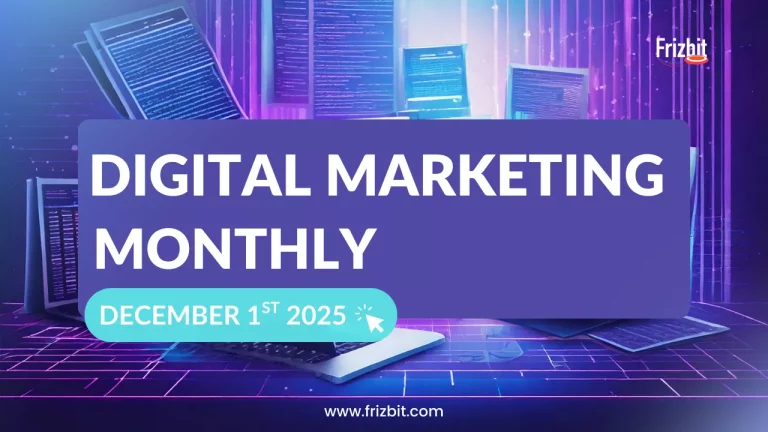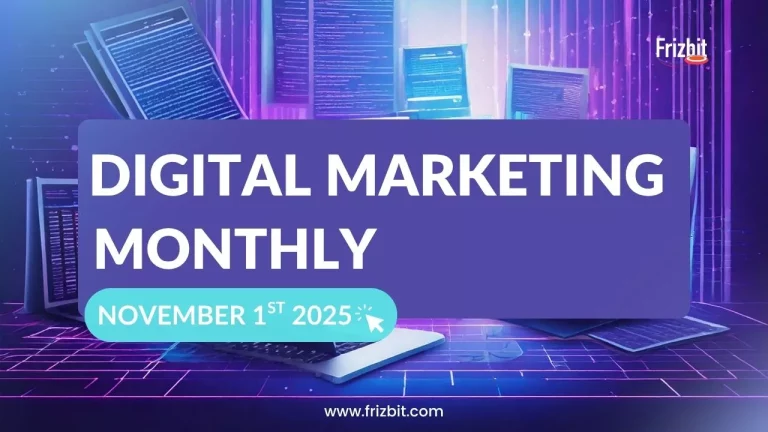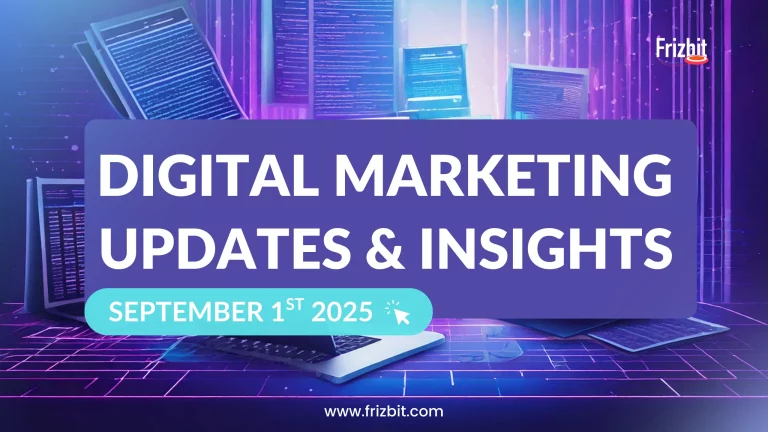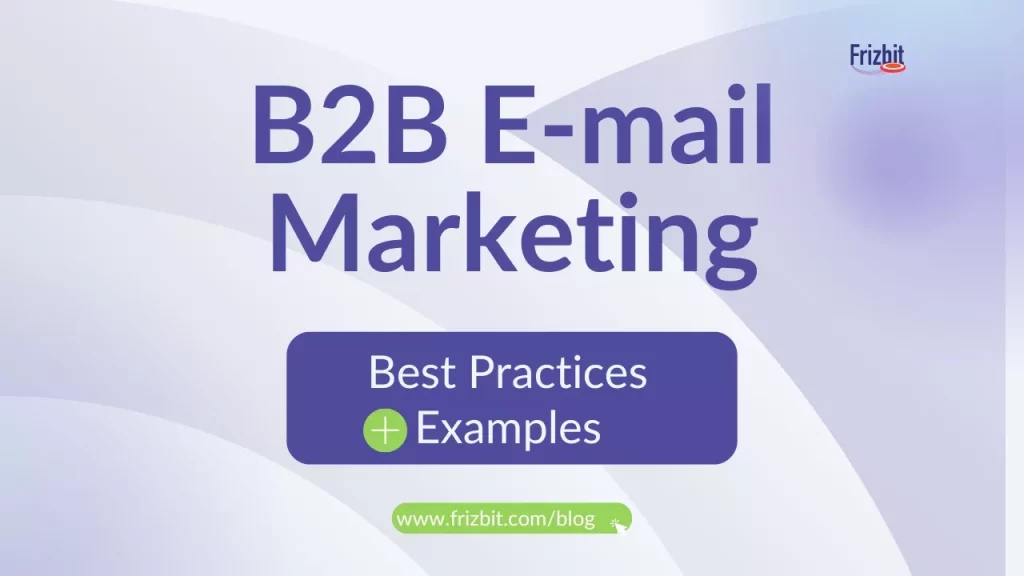
B2B email marketing is an essential component of any business’s digital marketing strategy, with 77% of B2B buyers say they prefer to be contacted by email than any other channel. Learning B2B email marketing best practices is key for any business wanting to obtain successful results.
It provides a direct line of communication to key decision-makers, allowing businesses to nurture leads, build relationships, and ultimately drive sales.
However, creating a successful B2B email marketing campaign requires a nuanced approach that differs significantly from B2C strategies.
In this blog, we’ll explore the best practices for B2B email marketing, including actionable tips and examples that can help elevate your strategy.
What is B2B Email Marketing?
B2B email marketing refers to the process of using email campaigns to communicate with other businesses, typically targeting decision-makers within those companies. The goal is to promote products or services, nurture leads, and drive conversions.
Unlike B2C email marketing, which often focuses on emotional appeals and consumer behaviour, B2B email marketing requires a more data-driven, logical approach.
This involves offering value through insightful content, hyper-personalised messages, and addressing specific business needs.
Why a B2B Email Marketing Strategy is Crucial
A well-crafted B2B email marketing strategy is crucial for several reasons:
- Targeted Communication: B2B email marketing allows you to segment your audience and deliver tailored content that resonates with each segment’s specific needs.
- Cost-Effective: Email marketing remains one of the most cost-effective channels for B2B companies, offering a high return on investment when executed correctly.
- Measurable Results: With the right tools, B2B email campaigns are easily measurable, allowing you to track open rates, click-through rates, and conversion rates to refine your strategy continuously.
- Lead Nurturing: B2B sales cycles are typically longer and more complex than B2C. Email marketing helps nurture leads through the different stages of the buying process, providing the necessary information and resources to move them closer to a purchasing decision. To explore more, check out our comprehensive email marketing guide.
B2B vs B2C Email Marketing Best Practices Comparison
When it comes to email marketing, the approach you take can vary significantly depending on whether your audience is composed of businesses (B2B) or individual consumers (B2C).
While both B2B and B2C email marketing share the common goal of driving engagement and conversions, the strategies, tone, and execution differ greatly due to the distinct nature of the target audiences and their decision-making processes.
The table below highlights the key differences between B2B and B2C email marketing best practices, focusing on aspects such as audience segmentation, content focus, sales cycles, and more.
Understanding these differences can help you tailor your email marketing campaigns more effectively to meet the specific needs of your audience, and understand where the line draws when crafting B2B email marketing campaigns.
| Aspect | B2B Email Marketing | B2C Email Marketing |
| Audience | Decision-makers in businesses, typically segmented by industry, role, or company size. | Individual consumers, often segmented by demographics, behaviour, or interests. |
| Content Focus | Data-driven, logical content that addresses specific business needs and pain points. | Emotionally-driven content that appeals to consumer desires and lifestyle. |
| Sales Cycle | Longer, involving multiple stakeholders and more complex decision-making processes. | Shorter, with more impulsive purchasing decisions. |
| Tone | Professional and informative, focusing on expertise and value. | Conversational and engaging, often using playful or persuasive language. |
| Personalisation | Highly personalised based on industry, role, and stage in the buying cycle. | Personalisation based on consumer behaviour, preferences, and past purchases. |
| Call to Action (CTA) | Focused on generating leads, nurturing relationships, and driving conversions. | Focused on driving immediate sales, promoting offers, and enhancing brand loyalty. |
| Frequency | Less frequent, typically one to two times per week. | More frequent, sometimes daily or multiple times per week. |
| Metrics of Success | Open rates, click-through rates, lead generation, and conversion rates. | Open rates, click-through rates, sales conversions, and customer engagement. |
| Challenges | Deliverability issues, maintaining relevance, and compliance with regulations like GDPR. | Standing out in a crowded inbox, avoiding spam filters, and maintaining high engagement rates. |
B2B Email Marketing Examples
Exploring successful B2B email marketing campaigns can provide valuable insights and inspiration for your own strategy. Here are five examples of B2B email campaigns that have effectively engaged their audiences:
1. Buffer’s Welcome email Series:

Buffer, a social media management tool, sends a welcome email series to new users that introduces them to the product and offers tips on how to get the most out of it.
What they are doing right:
The series is personalised and segmented based on the user’s engagement level, ensuring that the content is relevant and timely.
Zoom Lead Nurturing Campaigns
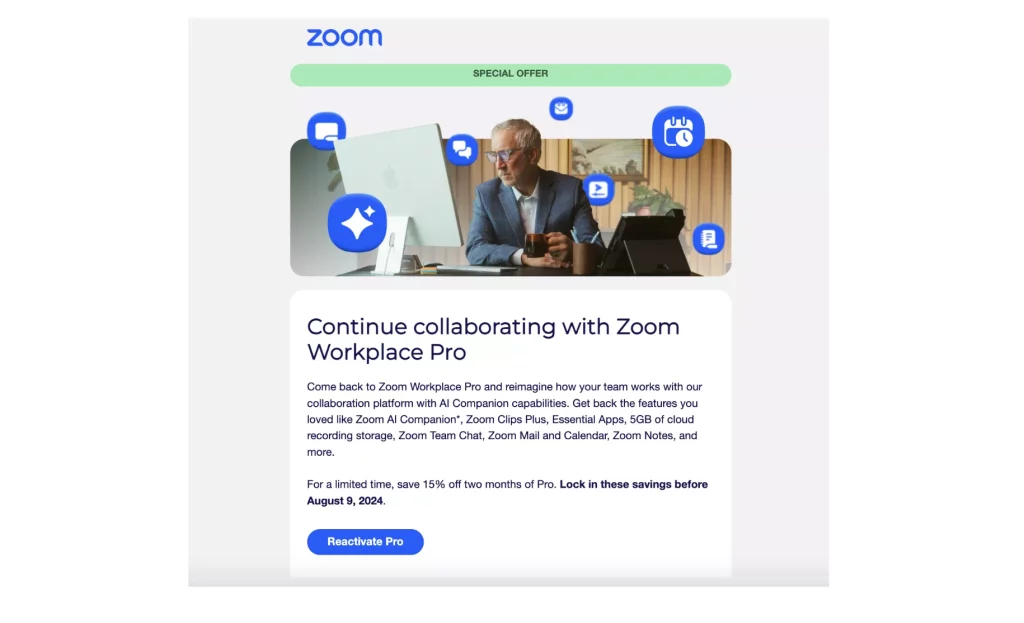
Lead nurturing emails are crucial for engaging leads with high purchase intent, guiding them toward making a purchase. These emails should include direct calls-to-action like “Shop now” or “Buy now,” but only target those who have shown clear intent, such as adding items to their cart or abandoning a purchase.
What They Are Doing Right:
- Precise Targeting: Focusing on leads who have demonstrated interest ensures relevance and increases conversion chances.
- Clear CTAs: Direct and unambiguous calls-to-action prompt immediate responses.
- Data-Driven Segmentation: Using behavioural data to personalise emails enhances their effectiveness.
Pro Tip: Avoid pressuring casual visitors or new subscribers with these emails. Use data to identify the right audience before launching your campaign.
3. Metricools’s New Product Feature Email
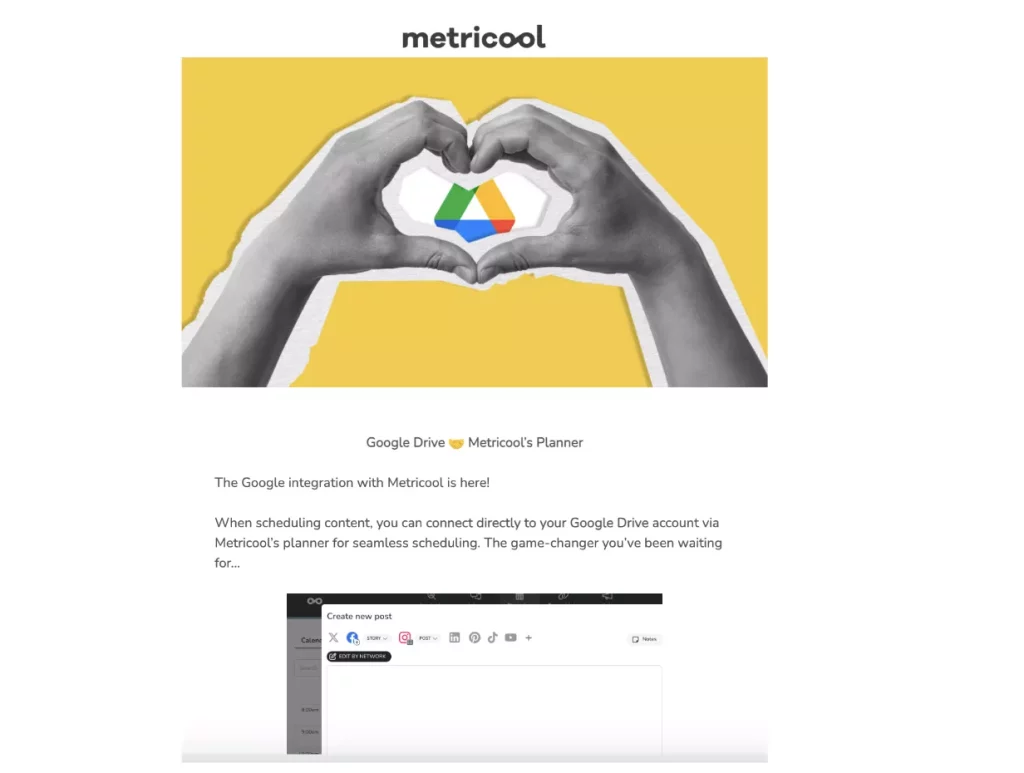
Metricool sent a B2B email to notify clients about a newly added feature to their platform. The email effectively combines brief how-to content with explainer graphics, guiding users step-by-step on how to use the new feature.
What They Are Doing Right:
- Clear Communication: The email provides straightforward instructions, ensuring users understand how to utilise the new feature.
- Visual Aids: The use of explainer graphics complements the text, making the information more accessible and easier to follow.
- User-Focused Design: The content is arranged in a logical sequence, making it simple for users to engage with the new feature.
4. LocaliQ Year in Review Email

LocaliQ sent a B2B email summarising the company’s achievements over the past 12 months. While not every company can publish an annual report, this email effectively showcases the brand’s biggest wins and milestones in a concise, engaging format.
What They Are Doing Right:
- Celebrating Success: Highlighting key achievements helps build credibility and fosters trust with clients.
- Engagement through Reflection: Recapping the year’s successes keeps the audience informed and invested in the company’s journey.
- Brevity and Focus: The email summarises significant moments without overwhelming the reader, making it impactful and easy to digest.
Grammarly’s Insights email
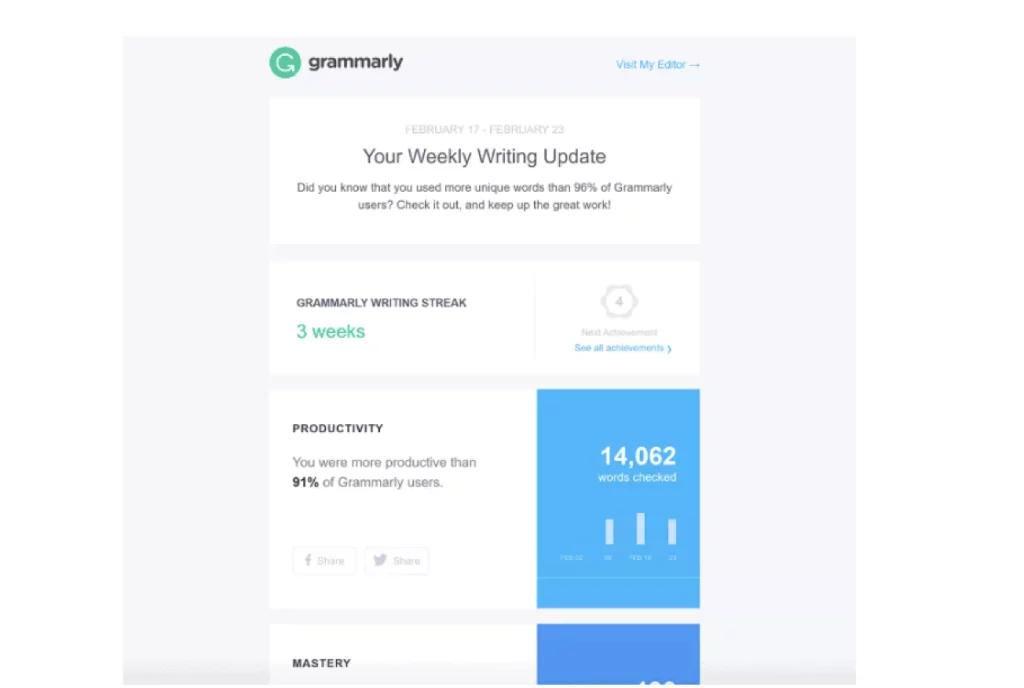
Grammarly taps into people’s love for competition with its Insights email. This personalised B2B email shows users how they rank against Grammarly’s 20 million other users worldwide. By providing unique, personalised data, this strategy not only engages users but also encourages them to use the service even more.
What They Are Doing Right:
- Personalisation: Offering unique insights that users can’t find elsewhere adds significant value.
- Engagement through Competition: Ranking users fosters a competitive spirit, driving continued engagement with the service.
- Inspiration for Continued Use: By showing progress and rankings, the email motivates users to keep improving and using Grammarly.
These examples showcase different approaches to B2B email marketing, from welcome series and educational content to product updates and case studies.
By studying these successful campaigns, you can gain inspiration and insights to apply to your own B2B email marketing strategy.
B2B email Marketing Tips
To ensure your B2B email marketing campaigns are effective, consider the following tips:
- Focus on Personalisation: B2B emails that feel personalised are more likely to resonate with the recipient. Use the recipient’s name, company name, and tailor content based on their industry or job role. Incorporating a hyper-personalised message can significantly improve engagement.
- Segment Your Audience: Not all leads are the same. Segment your audience based on factors such as industry, company size, and stage in the buying process to deliver more relevant content.
- Craft Compelling Subject Lines: The subject line is the first thing your audience sees. Make it compelling, clear, and concise. A/B test different subject lines to see which resonates best with your audience.
- Provide Value: Each email should offer something of value, whether it’s industry insights, product information, or educational content. Focus on addressing the recipient’s pain points and how your product or service can solve them. For more on best practices, explore our email marketing practices.
- Optimise for Mobile: Many professionals check their emails on mobile devices. Ensure your emails are mobile-friendly with responsive design and concise content.
- Include a Clear Call to Action (CTA): Each email should have a clear CTA, guiding the recipient towards the next step, whether it’s downloading a resource, signing up for a webinar, or contacting your sales team.
- Test and Optimise: Regularly test different elements of your emails, from subject lines to content layout, to identify what works best. Use the data to continually refine your strategy.
Common Challenges in B2B email Marketing
While B2B email marketing offers numerous benefits, it also comes with its own set of challenges. Addressing these challenges effectively can make the difference between a successful campaign and one that falls flat:
- Deliverability Issues: Ensuring that your emails reach the intended inbox is a common challenge. Factors such as spam filters, blacklisted domains, and outdated email lists can all affect deliverability. To overcome this, regularly clean your email lists, use a reputable marketing automation platform, and avoid spammy language in your subject lines and content.
- Engagement Levels: B2B emails often face lower engagement rates compared to B2C emails. This is due to the nature of the audience, who may be inundated with emails and have limited time. To boost engagement, focus on delivering highly relevant, valuable content, and experiment with different formats, such as interactive emails or personalised videos.
- Compliance with Regulations: Navigating regulations such as GDPR (General Data Protection Regulation) can be complex. Failing to comply can result in hefty fines and damage to your brand’s reputation. Ensure that you have clear opt-in processes, provide easy opt-out options, and be transparent about how you use and store personal data.
- Maintaining Relevance: With long sales cycles, it can be challenging to keep your emails relevant to recipients. To maintain relevance, segment your audience based on their position in the sales funnel, and tailor your content to address their current needs and concerns. Using email marketing automation can help manage this complexity effectively.
Email Marketing Best Practices: Measuring Success Metrics

Understanding the effectiveness of your B2B email marketing campaigns is crucial for continuous improvement. Here are the key metrics to track:
- Open Rate: Indicates how many recipients opened your email. A low open rate could signal that your subject line isn’t compelling enough.
- Click-Through Rate (CTR): Measures how many recipients clicked on links within your email. A high CTR indicates that your content is engaging, and your CTA is effective.
- Conversion Rate: Tracks the percentage of recipients who completed a desired action, such as filling out a form or making a purchase, after clicking through your email.
- Bounce Rate: Refers to the percentage of emails that couldn’t be delivered. A high bounce rate may indicate issues with your email list quality.
- Unsubscribe Rate: The percentage of recipients who opted out of receiving future emails. A high unsubscribe rate could mean your content isn’t resonating, or you’re sending emails too frequently.
Q&A: B2B email Marketing
Q: How often should I send B2B emails?
A: The frequency of your emails depends on your audience and content. Generally, sending one to two emails per week is considered optimal for most B2B audiences. However, it’s important to monitor engagement levels and adjust accordingly.
Q: What is the best time to send B2B emails?
A: Studies show that Tuesday to Thursday, during mid-morning (around 10 AM), tend to have the highest open rates for B2B emails. However, this can vary depending on your audience, so testing different times is recommended.
Q: How do I avoid my B2B emails going to spam?
A: To avoid spam filters, ensure your emails are sent from a reputable domain, include a clear subject line, and avoid using too many promotional words. Also, encourage recipients to add your email address to their contacts.
Conclusion: Implementing B2B email Marketing Best Practices
Implementing these B2B email marketing best practices can significantly enhance your marketing efforts, helping you to build stronger relationships with potential clients and drive better results. Whether you’re just starting or looking to refine your existing strategy, the key is to remain focused on delivering value, personalising your content, and continually optimising based on performance data.
At Frizbit, we specialise in implementing tailored cross-channel marketing automation that align with your business goals to help you bring customers back and activate purchases in autopilot.
Contact us to enquire for a free demo with our team.

